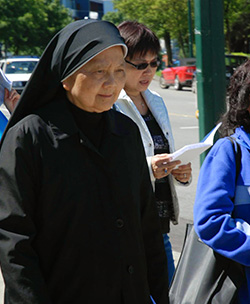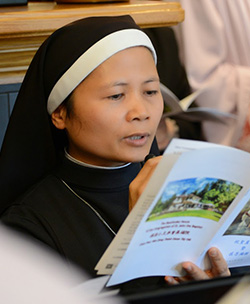Sister Veronica Tang’s Vocational Journey
Before she was given the name Veronica, she was Tang Wai Ying, born in Hong Kong and raised in a generations-old Buddhist family. She could not have known what God had planned for her and how she would make the difficult journey to God and the Catholic faith.
When she was only 15 years old, Wai Ying was walking by Good Hope School, and her attention was captured by a painting on the school walls: a picture of a beautiful lady dressed in white with a blue sash. This painting was of Mary, mother of Jesus. Wai Ying was so impressed by the picture that on returning home, she asked her father if she could transfer to Good Hope School.
Now Good Hope School was not Buddhist, it was run by the Sisters of the Immaculate Conception. Mr. Tang was reluctant to let his daughter study in a Catholic school. Wai Ying attended a Buddhist school; her family had been Buddhists for five generations. Somehow, in the end, Mr. Tang agreed to let his daughter change schools.
Later, Wai Ying volunteered at the Maryknoll Catholic Early Childhood Education Centre in the district of Wong Tai Sin in Kowloon. Her work was to look after the staff room for the daycare teachers, and it was there that she met a novitiate who taught her to recite the prayers of the Rosary. As Wai Ying and the novitiate worked together each day, she was impressed by her friend’s spirituality and good examples.
After some time, Wai Ying decided that she wanted to receive the Sacrament of Baptism. She brought up the subject with her father. When he was a young man, taught by Jesuit priests, he also wanted to receive Baptism, but his parents - Wai Ying’s grandparents - did not allow him. At first he would not approve. In the end, Wai Ying was baptized at St. Teresa’s Church in Kowloon.
Wai Ying continued working at the Maryknoll Catholic Early Childhood Education Centre. She told one of the novitiates of the Sisters of the Immaculate Heart of Mary that she wished to fulfill a religious vocation. She was advised to visit the Novitiate Mistress, Sister Rose Chan, who taught Wai Ying to pray to Mary, Mother of God and ask for guidance.
When Wai Ying made up her mind to enter the convent, she was only 18 and she required her father’s signed permission to enter the convent. She knelt in front of her little statue of St. Joseph, praying from morning until her father returned home in the late afternoon when she asked for his consent to enter the Convent of the Immaculate Heart of Mary. There was much disagreement from her family, going as far as Wai Ying’s mother threatening aloud to kill herself. Mr. Tang relented towards his daughter and signed the forms.
When time came for Wai Ying to enter the convent, there was one more hurdle. She had to find a way to raise $600, a dowry or contribution to the general funds of the convent. Her oldest brother, a firefighter, supported her and provided the substantial sum she needed.
On the day she was to leave her home, Wai Ying’s mother tried to hang herself from the balcony of the house. The quick action of her brother saved Mrs. Tang, averting tragedy on what would be the first day of Wai Ying’s new spiritual life. Years later, Wai Ying’s brother was also brought into the church by baptism.
Now that Wai Ying’s family hurdles were behind her, she could finally focus on her calling which she had yearned for: a vocation to the religious life. She spent her novitiate days in a peaceful, joyful environment at the Sisters’ residence in the Mount Davis area with the ocean as the foreground and the mountain as the background.
After hard work and daily prayers, training and discernment, Sr. Veronica Tang, as she became known, took her Professional Vow on August 15, 1963, on the Feast of the Assumption of the Virgin Mary. Two years later, in front of God’s altar, she made her Final Vow, joining His religious flock so that she could dedicate her entire life to His service.
In the following 15 years, Sr. Tang became a daycare teacher in Hong Kong and studied in England. While she was abroad, her Mother Superior in Hong Kong told Sr. Tang of an invitation from Fr. Aloysius Lou to travel to his parish, St. Francis Xavier, in Vancouver, Canada to help with pastoral ministry and advocate for a daycare centre. Sr. Tang prayed to Mother Mary, to lead her to the right decision. So in July 1983, she flew from London to Vancouver. The airline lost her luggage and her flight was three hours late, but waiting patiently at the airport was Fr. Lou.
That fall, Sr. Tang started work on planning a new daycare and consulted with City Hall on the design of the St. Francis Xavier Daycare Centre in Vancouver’s Chinatown. In order to be able to teach in Vancouver, Sr. Tang went to night school to get additional BC certification. With the heavy course load and the housekeeping chores at the parish rectory, it was a very busy time for her. When the St. Francis Xavier Montessori Pre-School Daycare Centre was finally completed, Sr. Tang became the first principal and held the position for 17 years.
As the city of Vancouver developed and grew, many young families moved out of the city. And to better serve these families in her mission, Sr. Tang thought of establishing a daycare in the urban area of Coquitlam. Over many years and with the support of many, including the Mother House in Hong Kong, parishioners, government ministries and private donations, land and buildings were purchased. The Mayor of Coquitlam issued the license, and on August 13, 1994 the Coquitlam Daycare was blessed by Fr. Lou and officially opened by the Coquitlam Mayor Louis Sekora.
When the Daycare in Coquitlam was completed, Sr. Tang again became the principal. Three Sisters from the Hong Kong congregation arrived in Canada to help.
In addition to her responsibilities as a daycare administrator, Sr. Tang instructs in the Rites of Catechism Initiation for Adults (RCIA). She also oversees some of the activities at Our Lady of Fatima Church in Coquitlam such as organizing a Cantonese Mass twice a month and serving the converts who help with the ground maintenance of the property.






